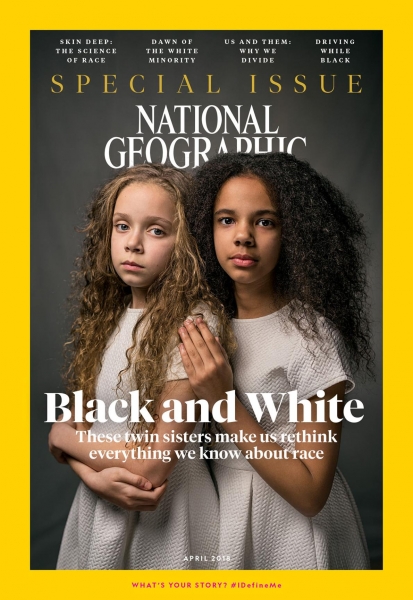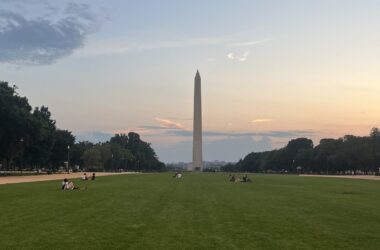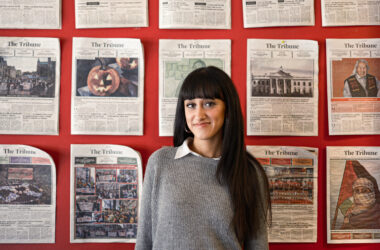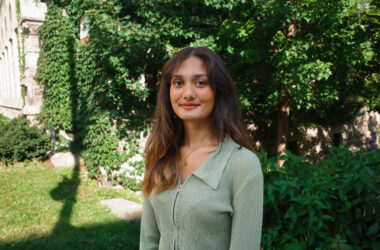When I first read Patricia Edmonds’ cover story on Millie and Marcia Biggs—half-black, half-white fraternal twins—for National Geographic’s April 2018 Race Issue, I felt conflicted. As a person of mixed race, with a father from Hong Kong and a mother of largely Scottish descent, I was happy for this family’s opportunity to share their experiences. Although national media are increasingly latching onto stories about race, people of mixed race don’t often get the spotlight.
National Geographic’s cover is undoubtedly an attempt to normalize multiraciality and destabilize false notions of ‘race’ as a natural category. Yet, by focusing on the visual differences between the twins, the article misses more meaningful and nuanced questions of culture and identity that people such as myself often grapple with. Instead, it places mixed race children on a pedestal that risks exoticizing them.
Edmonds claims that people are more accepting of racial differences now than they once were: While the twins understand what racism is, their parents apparently have not witnessed racist behaviour towards their daughters. However, even if based on interviews with the family itself, the picture painted by National Geographic overlooks the complexity of the varied manifestations of racism, or at least racial categorization. If the author is (rightly) asserting that race is an invented category with no scientific basis, it’s odd, then, to title the issue “Black and White.” Paradoxically, the article critiques the way we think about race, while at the same time fixating on the twins’ stunningly contrasting appearances.
As Doreen St. Félix points out in the New Yorker, society latches onto mixed race people with a sort of removed fascination: Liberals vaunt them as “diviners of social progress,” while simultaneously ignoring that multiracial individuals are by no means new, particularly among colonized populations. Yet, our collective trouble with understanding multiraciality is not surprising, given that systems of racial classification have been ingrained in us for so long. Questionnaires ask us to choose from options like “white,” “Black,” “Hispanic,” “Asian,” and the the catch-all “mixed race” because, for statistical purposes, this is all that matters.
The end result is that mixed race people in their day-to-day lives generate a lot of intrigue and confusion. A stranger got mad at me once because he couldn’t guess what race I was, and thought that I was lying to him. Friends—mid-winter—ask me incredulously how I’m so “tanned,” leaving me at a loss for words, as if my skin doesn’t belong on my body. Like any person who doesn’t fit into a box, the twins intuitively know the awkwardness of responding to this disconnect, too, as they often have to clarify that they are in fact sisters.
To suggest that half-white children embody the possibility of a post-racial future betrays the fact that we haven’t yet figured out how to understand them. Because skin colour and visual appearance are readily noticeable, in my own experience, the same weight is not attached to cultural background or identity. Yet, the things that matter—that I want to share with my friends, or pass onto my children—are not my brown skin and dark hair, but my childhood of Chinese martial arts and large family dinners and my dad’s love of Hong Kong.
National Geographic’s cover is unsettling because at the same time that it affirms the falsity of race as a concept, it focuses entirely on contrasting visual appearances. In this way, it reminds me far too much of my own lifetime of uneasy interactions, during which I’ve lost track of the number of times that perfect strangers have asked me, “What are you?”. It’s not that I mind the question, per se—there is a part of me that likes the thrill of being different and unique, and the weird sense of satisfaction I get when I surprise people with my ethnicity. What bothers me is that my skin colour and facial features are dwelled upon at the expense of my cultural background. Because I don’t look Chinese, any real, meaningful connection to my Chinese heritage is assumed to be nonexistent or irrelevant, or worse—a racist joke punchline. Any claims of attachment I might have to that part of myself are somehow less legitimate because I don’t look the part.
The crux of being mixed race—particularly, half-caucasian—is that one is at once neither and both, occupying a weird in-between space that society hasn’t yet figured out how to make sense of. My fundamental discomfort with the National Geographic story—as honest as it is in its intentions—is that it still uses racial appearance as a reference point. Further, it implies that half-white children have overcome racism, when their realities are far more complicated. The more interesting questions are how it feels to be Millie or Marcia—how they navigate between the varying influences in their lives, where they find common ground between them all, and how all of this informs their identity, values, and experiences.









The author of this article states: ” Questionnaires ask us to choose from
options like “white,” “Black,” “Hispanic,” “Asian,” and the the
catch-all “mixed race” because, for statistical purposes, this is all
that matters.” First of all, 95% of questionnaires do NOT ask for “mixed race.” They ask people to check as many as apply, including all federal forms and the U S Census. The other percentage ask for “multiracial,” which is the preferred terminology, not mixed race. An yes, statistics and data matter. This is not a well-researched article. Go to projectrace.com for accurate information.
I think you’re missing the point of the article. It’s about personal experience, and the author’s point about checking boxes is that a box labelled “mixed race” or “multiracial” does not do a good job of representing a plurality of experiences.
But those boxes don’t really exist, at least not in any way that is important. Not sure that the complaints about the article have a lot of merit either: I’m not sure how you’re supposed to challenge the idea that skin colour is meaningful without directly addressing the beliefs that people have that skin colour is meaningful. You can’t disprove an idea like that that without speaking to it.
Moreover, it isn’t just “about personal experience.” It’s a critique of an magazine cover, with virtually no reference to the article to which it is attached. Almost like the author was endorsing drawing conclusions on surface appearances. There’s a certain inconsistency there.
The author does reference the points made by the author of the NatGeo article though, and compares them with the message on the cover. They were contrasting the messages in both. It seems you have overlooked the second and third paragraphs.
As for your first point, I’m not sure I understand. These boxes do exist on government forms, and in surveys from different organizations (at least, here in Canada). I also don’t think the point of this piece was solely to disprove the idea that skin colour is meaningful. It’s arguing that society does not yet understand how to make sense of the experiences of multiracial individuals. The author calls for greater interest in understanding the varied experiences of these individuals by adopting a different approach. They argue that NatGeo should be asking questions about how one can navigate varying influences in one’s life, and how these influences inform their identity.
I didn’t overlook those paragraphs. Those paragraphs did not grapple with any specific ideas advanced in the article, or hint at the content of any of the related articles in the issue. It’s criticism without context. An argument that an article in Nat Geo should have set out to do
something other than what it intended, instead of whether it succeeded
or failed or not at what it did intend is not fair or useful criticism. And you are incorrect: on Canadian government forms, the germaine demography options are choose all that apply. Private surveys will vary, but private surveys are not mandatory, and there was no indication that any meaningful ill-effect could come to anyone from a) not filling private surveys out or b) not having one’s identity perfectly captured by such a survey. Media criticism is one of the easiest things in the world to do: cite the error, demonstrate what it is. “Cut. Paste. Complain.” It doesn’t really have the same effect when you skip the first two steps.
“National Geographic’s cover is undoubtedly an attempt to normalize multiraciality and destabilize false notions of ‘race’ as a natural category. Yet, by focusing on the visual differences between the twins, the article misses more meaningful and nuanced questions of culture and identity that people such as myself often grapple with.”
The author literally indicates what NatGeo intended to do with their piece, and then explains how their approach wasn’t nuanced enough.
The hegemonic society that we live in creates a racial contract that prescribes ignorance for white people. More specifically, ignorance not as an absence of knowledge, but as productively cultivated to prevent knowing. The “white gaze” that exists reinforces the racial differences that have been engrained in our society. The very idea of race implies a false commonality among members of racial groups that tends to mask internal diversity. A person is always more than the sum of such identities, but for some reason America cannot grasp this. As a society, we have attributed differences between individuals as a negative quality. Equality and distinctiveness are by no means at odds with one another. Our racial insensitivities are passed down from generation to generation, duplicated through our thoughts, actions, and political views.
As commendable as acknowledging its own racial past is, the National Geographic is simultaneously reinforcing stereotypes. Racial ills like racial insensitivity, racial ignorance, and race based judging rear their ugly heads as the cover story depicts these twins as rare and truly unique. I understand what the issue is trying to do, they’re attempting to point out the fact that although these girls have different skin colors, they are essentially the same person, showing that skin color is not a factor in what type of person you are. But in all reality, this story is actually for white people. The “white gaze” is so focused on color differences that the difference between these two girls is seen as truly unique and worth addressing. To black people, this is just another situation to where it is pointed out that one of them is black.